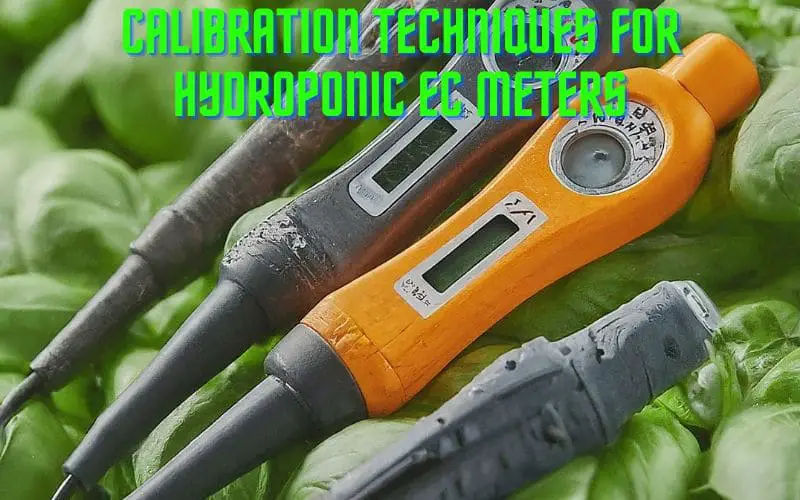Top 3 EC Calibration Techniques for Hydroponic Solutions

Introduction
Welcome to the world of hydroponics! In this article, we will explore the fascinating realm of EC calibration techniques for hydroponic solutions. Whether you’re an experienced hydroponics enthusiast or just starting out, understanding the electrical conductivity (EC) calibration methods is vital for the success of your hydroponic system. So, buckle up as we delve into the top 3 EC calibration techniques and equip you with the knowledge to optimize your hydroponic solutions.
1. Electrical Conductivity (EC) Calibration Solutions
Overview
Electrical conductivity (EC) calibration solutions play a crucial role in maintaining the accuracy of EC meters used in hydroponic systems. These solutions are specially designed to provide known EC values, enabling users to calibrate their meters and obtain precise measurements. Let’s delve deeper into the significance of EC calibration solutions and the techniques involved.
EC calibration solutions are indispensable for ensuring the reliability and precision of EC meters. They serve as reference points for establishing the correct conductivity measurements, thereby enhancing the overall effectiveness of hydroponic cultivation.
There are three primary techniques that hydroponic enthusiasts commonly rely on for optimal EC calibration:
- Single-Point Calibration: This method involves using a single standard solution to calibrate the EC meter. It is a simple and quick technique suitable for certain applications.
- Two-Point Calibration: By using two standard solutions with different EC values, this method ensures a more comprehensive calibration, accounting for potential deviations in the meter’s readings across a wider range of conductivity values.
- Multipoint Calibration: This advanced technique involves calibrating the EC meter across multiple standard solutions with varying EC levels. It provides the highest level of accuracy and is particularly beneficial for precision-focused hydroponic systems.
2. Calibration Procedures for EC Meters
Overview
Calibrating EC meters is a crucial step in maintaining the accuracy of readings and ensuring the proper functioning of the hydroponic system. The calibration process involves specific procedures to adjust the meter’s readings based on the known EC values provided by the calibration solutions. Understanding the calibration procedures is fundamental for any hydroponic enthusiast seeking to maintain precise control over nutrient levels.
When calibrating EC meters, it’s essential to use high-quality calibration solutions with known EC values. These solutions serve as reference points for adjusting the meter’s readings and ensuring reliable measurements. Additionally, the calibration process should be conducted in a controlled environment to minimize external factors that could impact the accuracy of the readings.
Furthermore, proper maintenance of EC meters is integral to the calibration process. Regular cleaning and storage in suitable conditions help preserve the accuracy and functionality of the meters, contributing to consistent and dependable readings. Diligent maintenance also extends the lifespan of the meters, reducing the need for frequent recalibration.
Understanding the relationship between EC values and nutrient levels is essential when calibrating EC meters. By comprehending the impact of varying EC levels on plant health and growth, hydroponic enthusiasts can make informed decisions when adjusting the meter’s readings. This knowledge allows for precise control over the nutrient concentrations in the hydroponic solution, promoting optimal conditions for plant development.
3. Importance of EC Calibration in Hydroponics
Overview
The importance of EC calibration in hydroponics cannot be overstated. Accurate EC measurements are vital for monitoring and adjusting nutrient levels in hydroponic solutions, thereby promoting optimal plant growth and overall system health.Without proper calibration, the risk of nutrient imbalance and suboptimal plant performance increases significantly, emphasizing the critical role of EC calibration in hydroponic cultivation.
When it comes to hydroponics, EC calibration plays a pivotal role in ensuring that the nutrient solution provides the precise elements and concentrations necessary for robust plant development. This process involves the use of EC meters to measure the electrical conductivity of the nutrient solution, allowing growers to assess the concentration of dissolved salts and overall nutrient strength.
A well-calibrated EC meter is indispensable for maintaining the ideal nutrient balance, as it allows growers to make informed adjustments to the nutrient solution, ensuring that plants receive the appropriate levels of essential nutrients. The process of EC calibration also serves as a preventative measure against nutrient-related issues, such as over-fertilization or nutrient deficiencies, which can hamper plant health and productivity in hydroponic systems.
Moreover, the meticulous calibration of EC meters fosters precision in nutrient management, enabling growers to optimize the nutrient composition based on the specific needs of different plant varieties. In essence, EC calibration forms the cornerstone of effective nutrient management in hydroponic cultivation, underlining its significance in sustaining healthy plant growth and maximizing yield potentials.
Conclusion
In conclusion, mastering the art of EC calibration techniques for hydroponic solutions is a game-changer for any grower. By embracing the top 3 EC calibration methods and understanding their significance, you have the power to fine-tune your hydroponic system for maximum efficiency and exceptional plant growth. So, are you ready to take your hydroponic endeavors to the next level by harnessing the precision of EC calibration techniques?
